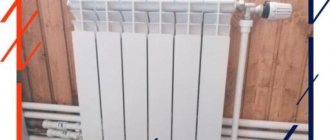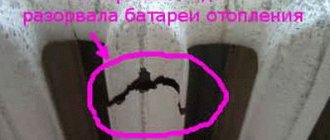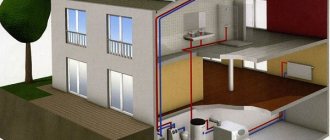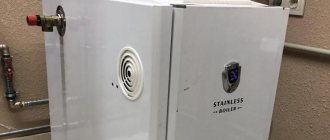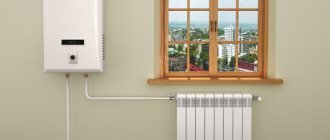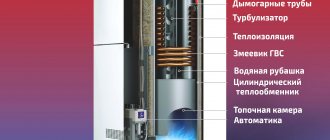Any private home requires its own heating system. When designing it, many factors should be taken into account, without which it will not bring the expected benefit. There are several types of radiator batteries. They are divided by type of metal, thickness and size. Each of them has its own positive qualities and disadvantages.
Therefore, before designing heating, it is worth paying attention to the type of water and the area of the heated room. On sale you can find aluminum, bimetallic, cast iron, and steel radiators.
Types of heating batteries
To choose radiators with the best performance for heating a private home, you need to understand the advantages and disadvantages of heating batteries that the market offers.
Each type of heating device should be considered based on the properties of the material and design features.
Radiators vary:
- by material of manufacture (steel, aluminum, cast iron, bimetallic);
- by design (sectional and solid);
- according to the principle of heat transfer (radiating thermal energy, convection and combined).
Steel
Among heating radiators for private homes, steel models are in steady demand. Their list of advantages includes:
- relatively light weight, which simplifies installation;
- fast heating and cooling – allows you to flexibly regulate the room temperature when using a thermostat, saving fuel;
- quite long service life;
- a wide selection of models with different functionality and appearance.
The disadvantages of steel heating devices include:
- tendency to corrosion - such batteries are designed for installation in a closed heating system, since the free penetration of air into the coolant accelerates the process of destruction of the metal;
- tendency to become overgrown due to the rough inner surface - regular flushing of the system is required;
- restrictions on the characteristics of the coolant - the addition of alkaline reagents should be avoided.
To understand which steel heating device to choose, we will consider each type in detail.
Manufacturers offer sectional, tubular, panel and convector steel heating devices.
Sectional
The battery consists of individual units, the number of which can be changed. This is a serious advantage of heating devices of this type. If the thermal calculation is performed incorrectly and the radiator power is not enough, additional sections are added.
If the house has been insulated and the need for powerful radiators has disappeared, it is enough to remove the extra sections to reduce energy consumption.
The advantages of sectional models also include a stylish design that will fit into any interior. The disadvantage is the large number of joints, which increases the risk of battery depressurization.
Tubular
They have an original appearance and are convenient for drying things. Reliable and durable due to the absence of joints - the radiator is a one-piece structure.
At the same time, it is important to choose the right heating device in terms of power, since it will not be possible to adjust this parameter.
Panel
Panel-type heating radiators are characterized by a stylish, laconic design. Unlike tubular and sectional batteries, panel models equipped with convective fins warm up the air in the room faster - the formation of a flow of heated air is added to thermal radiation.
The ability to create a thermal curtain makes panel radiators popular for installation in rooms with a large glass area.
Panel radiators, like tubular ones, are solid. Models of this type can not only be mounted on the wall, but also installed on the floor.
Convector
Water convectors consist of steel pipes on which numerous metal plates are mounted, mounted on an edge. The top of the heating device is covered with a stylish metal casing. There are models built into the floor. The gaps between the plates contribute to the formation of a flow of heated air.
It is recommended to install convector radiators along panoramic glazing, in a winter garden, in a room with high ceilings.
Due to natural convection, the room warms up faster than thermal radiation. When deciding which radiators are better, you should note that a system with water convectors requires a smaller volume of coolant compared to using other types of radiators. The disadvantages of convector radiators include their high cost.
In addition, during operation of such a battery, air currents constantly raise dust, which enters the human respiratory system.
Cast iron
When considering different types of radiators, one cannot ignore the classic option - cast iron batteries. To this day, working copies installed before the revolution have been preserved in old houses.
In Soviet-built houses, mass-produced cast iron radiators are used.
The advantages include durability and corrosion resistance, high heat transfer, and the ability to install additional sections. The list of disadvantages includes a tendency to overgrow - over time, the heat transfer of such batteries decreases, as the free space inside the case narrows. Unlike modern heating appliances, cast iron radiators require regular painting.
Disadvantages also include heavy weight, which makes transportation and installation difficult.
Before choosing a cast iron battery for a private home, you need to pay attention to its high thermal inertia. It heats up and cools down slowly, which makes it impossible to quickly regulate the microclimate in the room.
Today, in private homes, cast iron radiators are installed if they want to emphasize their individual image. Manufacturers offer original floor models, decorated with artistic castings, which will perfectly complement the interior in a classic style.
Aluminum
When deciding which heating devices are best for a private home, pay attention to aluminum models. Such radiators are in growing demand among private developers due to their light weight and ease of installation, attractive appearance, and the ability to add and remove sections.
The cost of the product depends on the manufacturer.
Domestic products are as affordable as possible; this is a budget country option. In a country house, it is better to install imported products; they are more reliable, but also more expensive.
Aluminum radiators:
- may leak due to the presence of threaded connections;
- aluminum is picky about the acidity of the coolant - using a liquid with unsuitable parameters damages heating devices;
- due to increased heat transfer, they can poorly warm the lower part of the room - the heated air quickly goes up and the floor remains cold.
But despite this, it is wise to choose an aluminum radiator for a private home - the metal quickly heats up and cools down, making it possible to quickly change the heating level of the room in accordance with weather conditions and microclimate requirements.
In this regard, aluminum batteries are the most practical.
Bimetallic
Such heating devices combine the advantages of steel and aluminum models. The inner surface of a durable iron alloy is undemanding to the characteristics of the coolant and ensures the structural strength of the battery.
The external aluminum casing is characterized by good heat transfer, due to which the radiator effectively warms the room.
The bimetallic radiator is designed for high operating and pressure testing, which makes it the optimal choice for installation in an apartment connected to a central heating network.
Considering the high cost of high-quality bimetallic models, in private homes it is better to use a budget option for heating, designed to work in an autonomous system.
Using steel radiators
Radiators made of steel have two types - panel and tubular frame. The first consists of a thin sheet of steel, which allows it to heat up quickly. Has a modern design. But if the paintwork is damaged, it begins to rust.
Water used as a coolant should not contain reagents, otherwise the metal will react. Such a battery cannot be supplemented with sections.
Steel tubular radiators come in a variety of designs and shapes. The inside is covered with a polymer layer, which provides it with anti-corrosion properties.
Rules for the location of batteries in the house
In order for the system to work properly, installation rules must be strictly followed. Although the installation technology is not complicated, it has its own nuances, so the work must be carried out by specialists.
Important! If radiators are installed incorrectly, they are not covered by the warranty.
In order to avoid heat loss and uneven heating of the room, when installing devices it is necessary to observe indentations and choose the correct location:
The most suitable option for the battery is considered to be a place under the window, i.e. where the heat loss is the most significant. The radiator width must be at least 70% of the window width. Mounted clearly in the middle.
- Leave at least 10 cm from the battery to the windowsill, as well as to the floor. The optimal distance between the floor and the radiator is 12 cm. It is not recommended to leave more than 15 cm.
- The battery is fixed at a distance of 5 cm from the wall.
- You can stick heat-reflecting material behind the radiator - then some of the heat will not go into the wall, but will return to the room.
- If the radiator is planned to be placed not under the window sill, but on the wall, then the distance between them should be at least 20 mm.
What are these devices?
Electric wall-mounted heating radiators, oddly enough, help save energy. In appearance they resemble ordinary radiators. Due to the ribbed surface, the volume of distributed heat increases significantly and in a short period of time the room becomes warm.
Radiant and convective heat exchange contributes to the direction of heat over the entire length of the radiator surface.
Of course, the power and heat transfer of a radiator depends on the number of its segments.
The battery casing can be made of bimetallic alloys or aluminum, which makes it similar to a conventional heating system battery.
Heating radiator rating
How were the best heating radiators selected?
In compiling the TOP list, experts assessed and compared those brands and models that are in greatest demand in the market and trusted by customers. In total, several dozen nominees were considered, after which the leaders were determined based on important technical criteria:
- Execution – sectional, tubular, panel;
- Body material – cast iron, steel, aluminum, bimetal, copper;
- Coolant – water, antifreeze;
- Installation – floor, stationary method;
- Working pressure – up to 10 atmospheres, up to 20 and higher;
- Thermal power - heat transfer in relation to the area of the room;
- Dimensions – height, width, depth, weight.
The ratio of quality, appearance, and price of each nominee was taken into account. Reviews from those who have personally used this or that unit are also important when compiling the rating.
They mention the ease of installation and maintenance of ROs, their resistance to corrosion and pollution, and the harmonious combination of design and interior.
Pros and cons of aluminum radiators
The light weight of the structures allows you to install radiators even on drywall. Good heat dissipation, nice design, and the ability to turn off each radiator using a valve make these batteries in demand. But there are also disadvantages.
Water that does not contain solid particles should be used as a coolant.
Aluminum is a fairly soft metal, so the operation of these radiators must be careful, especially with threads during the assembly of sections and on taps.
The best cast iron heating radiators
The very first model of radiators was made of cast iron, but modern modifications have greatly changed for the better. At first they were replaced by newfangled aluminum devices, and after some time, cast iron batteries became almost luxury items for a lot of money. On sale today you can see retro models with an accordion shape, panel, and designer options.
You can find out which cast iron heating radiators are better by analyzing the appearance, functionality and efficiency of the 3 models that are dissimilar to each other.
Konner Modern 500
A model with a well-known name on the Russian market, characterized by good energy efficiency indicators. One section holds up to 900 ml of water, which is higher than most similar devices. Accordingly, 12 sections of the Konner Modern 500 will be able to serve about 27-30 square meters. m.
In the presented selection, this is so far the most “not greedy” device for heat transfer. As for resistance to water hammer, 12 atmospheres is acceptable.
Advantages:
- European design;
- Good heating area;
- Reliability;
- Durability of cast iron;
- Price.
Flaws:
- Chinese production;
- Enamel does not tolerate high indoor humidity.
Compared to Soviet cast-iron heating radiators, this one is somewhat weaker, yet China will not be able to adapt such equipment 100% to living conditions in Russia.
Many users experienced enamel peeling, but this did not affect performance in any way.
Retrostyle Windsor 500
The most striking and atypical leader in the presented review of experts is considered to be a retro-style floor model with an atypical decor - Retrostyle Windsor 500. Uniqueness in the luxurious pattern in the style of the 18-19th century and artistic casting production technology.
The manufacturer guarantees long service life, strength and stability of the case.
The maximum water temperature is 110 degrees, its pressure is 10 atmospheres. The brand offers imitation of many models with such markings for brass, copper, and various precious metals.
Advantages:
- Elegant appearance;
- Imitation for luxury goods;
- Durable, durable cast iron;
- Completely sealed;
- High quality;
- Different number of sections upon request.
Flaws:
- Large dimensions;
- External massiveness.
Such a device can only be placed in a residential area with a corresponding retro, rococo, baroque, etc. interior. Dark color and massiveness require more free space in the room, otherwise the battery may look bulky.
The performance characteristics are good, there are simply no negative reviews about the battery.
Exemet Neo 4-660/500
Another cast iron model with a modern design for those who value long service and reliability. Due to the low height of the battery, it is possible to install it in rooms with panoramic glazing. You can see many tubes in the depth, this is necessary to improve the quality of heating.
The Neo 4-660/500 series has several options, each section of the heating radiator is presented in different quantities (maximum 34 pieces).
The operating water pressure inside should not exceed 10 atmospheres. There are several options for processing the surface of the case to choose from, for example, polishing with varnish, sandblasting, patination with silver, copper, bronze, etc.
Advantages:
- Floor installation;
- Reliability;
- 5 year warranty from the manufacturer;
- Low price compared to quality;
- Tubular shape with high heat dissipation;
- Custom design and coating.
Flaws:
- Will not fit into every interior style;
- High thermal inertia.
The more elegant the design of such a battery, the higher its price will be. But even under this condition, the amount will be much lower than that of imported European analogues. Due to the cast iron body, it will not be so easy to quickly change the temperature regime. But these are not so much significant disadvantages along with a long service life.
Classification of heating radiators
Today's radiator market is overcrowded with a very large number of heating equipment and it is not easy for an inexperienced person to understand this huge variety.
Heating devices differ in design features and the ratio of materials used in production - cast iron, steel, aluminum or bimetal.
Basic design varieties:
- Sectional. A more common type of design. These can be cast iron, aluminum, steel and bimetallic batteries.
- Monolithic. Monolithic bimetallic structures have higher technical characteristics compared to panel ones
- Panel. Steel batteries consisting of one or more panels. Heats rooms faster than sectional ones
- Tubular. Batteries can be cast iron, aluminum, steel or a combination of these
conclusions
When choosing radiators for a private house or apartment in a high-rise building, you should take into account the operating conditions typical for autonomous or centralized heat supply. Cast iron or bimetallic radiators are suitable for an apartment; aluminum or cast iron are suitable for a private house.
For the rest, you need to be guided by specific conditions: interior requirements, financial capabilities, equipment cost, manufacturer reliability, etc.
We recommend checking the calculation of the required number of radiator sections for a specific room by receiving the seller’s recommendations upon purchase.
During installation, it is necessary to maintain all the necessary distances of the radiator from the floor, walls, etc., as well as the horizontal position of its position in different planes.
A thermostat installed on radiators helps you save money - you can turn off unnecessary radiators or set an automatic temperature maintenance mode.
Radiators made of cast iron
Traditionally, during the construction of apartment buildings, inexpensive cast iron radiators are installed - one of the most durable and long-lasting heating devices. Due to their mechanical and corrosion resistance, they withstand:
- Increased acidity and hardness of the heat carrier
- Seasonal drainage of water
- Impact of sludge and litter
- Hydraulic shock, pressure up to 25-30 atmospheres
They are produced mainly in tubular, two-column sections, and in finished form, 7-8 sections per device.
Cast iron radiators are best used in centralized heating networks with poor preparation of the coolant.
Flaws:
- Heavy weight and bulkiness complicate the installation process
- Increased thermal inertia, which makes it difficult to adjust temperature
- Inconsistency with design requirements
Customer Reviews
Fedor D.
Royal Thermo Vittoria 500
done, in my opinion, well. Included with the documents is insurance: but it must be filled out in the store, with an online order you receive a blank form: but THE FACT OF Galicia insurance is a certificate of manufacturer's liability. Disadvantages: Upon leaving the delivery point, I found a rather large impact mark on the cardboard box (see photo, about 5 cm long, 2 cm deep). Most likely, they dropped it, for example, when loading/unloading it on the floor of a car, or hit it on a corner when they were carrying it, for example. Keep in mind that in addition to the cardboard box, the radiator is protected from the inside only by polyethylene with air bubbles. I opened the box, thank God, the blow ended up in the back of the battery in the gap with emptiness. On the back side there is a small, slightly bent section of one of the blades (see photo), but it’s not critical, it doesn’t affect anything (I hope).
Ruslan Lazarev
Rifar Supremo 500
Really cheap. The appearance is good, but this is for transportation. 12 sections in a completely cardboard box (hi rifar). Disadvantages: I was packing the radiator and one hole (as usual - out of spite) turned out. The left-hand (!) thread on the manifold. TENRAD connection kit. I pulled all the holes normally, even stronger and nothing, but here it is. I already had experience working with Rommer Optima BM 500 radiators; we bought them for my parents several years ago, so when I needed to buy radiators for my suburban home, I decided to use a company I already knew. They arrived, one box had a corner torn upon delivery, but the radiator was intact, so I didn’t refuse or replace it
Leonid Gromov
ROMMER Al Optima 500
I was pleased with both the packaging and the Optima batteries themselves. The corners and ends were laid with several layers of cardboard for reliability, the packaging arrived without dents, the batteries themselves are light, painted evenly, without burrs in the threads, and made neatly. We installed it after renovations in the apartment and have already tested it at work. The power is high, corresponds to the declared one, and does not leak anywhere. I chose a bimetallic radiator ROMMER Al Optima 500 for use in an individual heating system. The radiator is powerful, for our Russian winter and autumn. I checked the radiator in action. It does an excellent job, and is made so thoroughly that it should last a good long time. The price for such a radiator is really adequate. I wish the manufacturer was more represented in stores!
Pavel Kotov
Rifar Base 500
High quality radiator. Made very well. I hope it will last a long time. Radiator design! I had several selection criteria, in addition to heat transfer and reliability. Firstly, aesthetics. I just got rid of the cast iron monsters, why do I need a new freak in the house? Secondly, safety. Obviously, if there are children in the house, there is no need to buy the option with sharp edges. In addition, I paid attention to how easily the radiator can be cleaned of dust. The Rifar Base 500 passed the test on all counts and met all my requirements. Actually, 5 years have passed since the installation, and I am still satisfied.
Vladimir Mikhailov
ROMMER Al Optima 500
I decided to thoroughly start heating my house, since I simply had never gotten around to it. I installed these radiators in my country house. They heat well, hold heat well, and don’t smell anything. The old batteries were leaking and needed to be replaced with new ones. I didn’t go to the store, since in our city they are quite high. So I started browsing online stores. I came across a Romer Optima 500 radiator. It’s small, and the reviews are good. I ordered it for myself. They brought quite a lot. The radiators were securely packaged. I did the installation. Everything fit perfectly. I did a test run to check the joints for leaks. Everything is fine. I would like to note that the heat dissipation is good.
Andrey Bastrakov
Buderus Logatrend VK-Profil 22 500
The product corresponds to the description, heats perfectly, the heat transfer feels many times better than that of the previous Chinese analogue. In 2021, I took 2 radiators at once: one for the living room with 12 sections, one for the kitchen, 6 sections. There were no difficulties. Four years of operation is, of course, not twenty, while problems may not have appeared, but a 10-year guarantee inspires peace of mind. I don’t understand the negative reviews, either the plumbers did something wrong, or they bought some kind of fake on the market - everything works for me. As they say, “we’ll see,” but so far I don’t see any signs of failure. Before the start of the heating season, we specifically called the plumber for a consultation to check, just in case, that everything was in order. He said that everything was fine, although he advised us to replace the cast-iron batteries in the kitchen because they were getting clogged. But that's next year.
Alexander I.
Royal Thermo PianoForte 500
Availability of the product I was looking for, full consultation. At the time of purchase, the appearance was modern, well made, good heat dissipation, not made in China, 10 year warranty. After opening the package, I discovered a poor-quality coating inside the radiator, it’s clear that the drips of the coating were corrected - I noticed this because I installed it myself. The defect was on one of the three I bought. It would be nothing, but taking into account the fact that I paid more than 25 thousand for three radiators, I would recommend opening buyers packaging in the store and check the appearance.
Roman L.
Royal Thermo BiLiner 500
Advantages - high quality of manufacture and material of the battery, good packaging of the goods. The website indicated that it was made in Italy, in fact Russia. although this inaccuracy does not affect manufacturing. There are no plugs included, but this drawback is common to many manufacturers. This is not the first time I have installed such a battery. The first one has been working for about 10 years. there are no comments about it. provides better heat than a standard metal radiator, all other things being equal. When carrying out repairs, I will install the same ones in the future, there are few analogues.
Alexander M.
Rifar Monolit 500
Nice appearance, no sharp corners on the front side. One of the key advantages of the radiator is its resistance to external corrosion due to the use of special powder paint. In addition, this design provides visual appeal and aesthetics. It is unlikely that anyone will dispute the fact that the radiator fits perfectly into any interior. And, of course, the high heat transfer should not be underestimated. I stopped using air conditioning a long time ago: one small compact device was enough to provide a comfortable temperature.
Vladimir K.
Global STYLE PLUS 500
They heat 1.5 times better and faster than cast iron ms. They don’t transmit any noise (we don’t hear our neighbors through them, only through the ceiling, like people sneezing at night)) Again, the plus is that the rifar is monolithic and has no gaskets, which means they won’t leak. Unlike the classic monolith, the supremo radiator has 2 water passage channels, thereby increasing the speed and volume of heat transfer. I’m using it for the second winter and I’m happy with it. The coating did not fade or peel, unlike cheap Chinese Italian brands. better than clumsy dust collectors. I didn't find any cons. Probably their disadvantage is that they are expensive and that competitors of the domestic brand unreasonably criticize the Russian product. I can recommend it to those who freeze, as it copes with heat transfer 100%. I don’t want to advertise, but I don’t regret buying them.
Nastasya V.
Rifar Base 500
Good batteries, high quality and most importantly heat the room! The choice of radiators in Russia is very important, because climatic conditions require 6 months of cold weather. Unlike the Soviet past, when there was no alternative to heavy cast-iron batteries, modern manufacturers offer a wide selection of types of radiators. I settled on bimetal because this is perhaps the only option that combines reliability. In terms of heat transfer, there are no complaints: very warm. There are no complaints about sealing either, there have already been so many pressure surges in the system, but he doesn’t care.
Alexey Revenko
Global ISEO 500
minimalism, heat transfer is stronger than the Soviet ones! Lightweight, stylish, modern radiator. During the first winter I didn’t find any shortcomings. I bought it after the repair of the team, to replace the old Soviet ones. Before this, for some reason there were 2 batteries in the room, for 6 and 7 sections, so we decided to make 1 battery in the middle, for 10 sections. As a result, it warms even more than the old ones, although the room was always warm. So I advise you to take it (optional) with a water supply regulator so that you can sit and heat the room.
Batteries as an element of furniture
The principle of multifunctionality is now in trend. And if you manage to turn the battery into a piece of furniture, it will be a very convenient and stylish solution.
Now there are radiators that can be shelves, tables and even benches. Thanks to this approach, the necessary heating device acquires an additional role in the interior, which is no less important than creating a comfortable microclimate. When the radiators are turned on, it is especially pleasant to use such furniture - it is always very warm and cozy here.
Important: such solutions must be well thought out, ideally ready for use. An ordinary battery cannot be converted into a piece of furniture at will, as this will be too dangerous - if the structure cannot withstand the load, it will lead to an accident. The safest and most aesthetic option is to replace outdated batteries with modern models that not only provide heat, but also make your home more beautiful and comfortable.
The best solutions for the kitchen
The design of kitchens, not as strict as is customary for living rooms, gives free rein to imagination. In addition to the above-described ways to hide heating radiators, in the rooms where culinary masterpieces are created, designer delights are also created to decorate heating radiators. The radiator and the pipe connecting it to the heat source can be painted in the same color as the walls, decorated using the decoupage technique, or these two methods can be combined.
A battery painted to match the walls will be less conspicuous
An even greater effect can be achieved if you paint the battery to match the wallpaper
The battery can be displayed as part of an artistic composition
Many ideas are available on the Internet. Taking them as a basis, you can create a masterpiece on your own and without much labor or time, decorating the external elements of the heating system with an elegant or cheerful design. Battery decoupage involves transferring a design from a carrier onto the metal surface of a radiator. When decorated using the decoupage technique, batteries can be decorated using ready-made designs made on thin paper (both rice paper and ordinary decorative napkins are suitable). There are a lot of design options: flowers, wood decoration, geometric designs.
Rainbow battery
Khokhloma painting on a heating radiator
If you have artistic abilities, then you can do without ready-made solutions and apply paint directly to the surface. For such work you will need heat-resistant paints and varnish. The latter is necessary for those who decide to decoupage the battery themselves. For decoupage you will also need glue; regular PVA will do.
See alsoLifehacks for home and interior
For a private house or apartment?
There are dozens and hundreds of companies specializing in the production of radioactive materials. The competition is crazy. Marketers are coming up with new arguments in favor of their products. This makes the choice of characteristics richer, and making a purchase more difficult for the average buyer. Let's start with the simplest thing.
If you need a device for a private house or apartment with an individual heating system, then choose by power and design. Those. We saw a model we liked in appearance, selected it based on power/size – and that’s it. For an apartment in a multi-storey building, where the coolant is supplied through the pipes of a centralized heating system, you also need to take into account the operating pressure set by the manufacturer. It should not be lower than 10-12 atmospheres. Otherwise, the structure will tear when water is supplied.
Now let’s look at the types of heating radiators, traditionally presenting the data in the form of a “tiny” table.
Device options and their features
| Comparison criterion | Varieties | Characteristics |
| Execution | Sectional |
|
| Tubular |
| |
| Panel |
| |
| Radiator material | Cast iron |
|
| Steel |
| |
| Aluminum |
| |
| Bimetal (steel+aluminum) |
| |
| Copper |
| |
| Gasket material | Silicone | Withstands high temperatures, effectively compensating for the expansion of metal structures. Ideal for low pressure heating systems, for example in private homes. |
| Paronitis | Paronite is pressed rubber mixed with asbestos and other components. Durable, withstands high temperatures. It is most often used in centralized heating systems. | |
| Fluoroplastic | A product made of heat-resistant polymer that can be installed without lubrication. Withstands exposure to any type of coolant. | |
| Cardboard | Impregnated with oil paint, special cardboard successfully copes with its function in aluminum and bimetallic RO installed in private homes. | |
| Coolant | Water | We are not talking about plain water, but about specially prepared water. This is exactly what circulates in the centralized heating system. It limits the content of hardness salts (due to which salt deposits form in the pipes - scale) and oxygen (due to which the material corrodes and breaks down). Water requirements in the EU and the Russian Federation are different, so when purchasing a foreign-made heating radiator, it is recommended to take into account the chemical composition of the water in your heating system. If desired, you can find it out at the Housing Office. |
| Antifreeze | Antifreezes or “anti-freeze” agents are used for systems with an individual heating circuit. They are needed if there is a risk of the coolant freezing due to the boiler being turned off. As you know, coolant is always in the system. If, for example, in winter the water in the system freezes, then due to expansion it will rupture the pipes, radiator, etc. Antifreeze does not freeze at average sub-zero temperatures. Ethylene glycol, propylene glycol, and alcohol solutions can serve as such coolants. | |
| Installation location | Stationary | Traditional heating radiators installed in most apartments. Mounting to the wall is carried out using special pin or corner brackets |
| Floor-standing | The same as stationary devices, only they are installed on special legs. | |
| Operating pressure* | up to 10 atm. | Such values are predominantly typical for panel-type devices. |
| up to 20 atm. and higher | For tubular and sectional RO. | |
| Center distance | 350, 400, 500, 600, 700 mm | The distance between the axes of horizontal collectors, along which a device is selected for connection to the existing pipe distribution. |
| Connection method | Lateral one-sided. (subtype of side connection) | The most common and effective solution in terms of using the capabilities of RO. Connection from the side: from above - to the pipe supplying coolant, from below - to the outlet. |
| Diagonal (subtype of lateral connection) | Most often used when connecting long devices (from 2 m and above), which allows the coolant to be evenly distributed throughout the entire volume of the structure. Inlet from above, outlet from the lower opposite side. | |
| Saddle (subtype of side connection) | For sectional ROs when it is impossible to use other methods. Inlet and outlet from the bottom on opposite sides of the device. In this case, the heat exchanger power may drop by 10-20%. | |
| Lower | For connecting panel RO with hidden pipe routing under the floor. Inlet and outlet from below at a short distance. The efficiency of the radiator is lower than with lateral and diagonal connections. | |
| Thermal power** | values in a wide range | Characterizes the radiator’s ability to transfer a certain amount of heat from the coolant to the room per hour of operation. It depends not only on the size and design of the RO, but also on the temperature of the coolant, as well as the air in the room. |
| Dimensions | On average: height from 260 to 800 mm, width from 270 to 1800 mm, depth from 50 to 100 mm | Directly affect the thermal power of the device, because The volume of coolant circulating in the device depends on this. |
* Before choosing a device, you need to check with the housing office about the maximum pressure in the heating system. Remember that all radiators except aluminum ones are suitable for a centralized heating system!
** We are often asked about how to choose the right heating radiator based on power. To make life easier for you and yourself, we have developed a convenient calculator. Enjoy it for your health!
For those who want to estimate the thermal power on their own, you can use the following method. We determine the required values per unit area of the room: 100 W/m2 – one window and one external wall; 120 W/m2 – one window and two external walls (corner room); 130 W/m2 – two windows and two external walls (corner room). For example, there is a corner room of 20 m2 with two windows. Then the approximate power of the RO will be: 20 × 130 = 2600 W. Let's make an allowance for the fact that the nameplate characteristics of radiators are tied to the ideal operating conditions of the device - 10% is quite enough. In total, we get the required thermal power: 2600 × 1.1 = 2860 W.
All that remains is to decide on the desired model, which you can find among the 20 devices we have selected.
Brief description of RO models from the rating
| Brand and country of manufacture | Model and section/panel dimensions (W×H×D) | Material, rated heat flux per section/panel, W | Approximate price per unit/section |
| 1. Global (Italy) | STYLE PLUS 500 (80×575×95) | bimetal, 185 | from 1041 rub. |
| 2. RIFAR (RF) | ALP-500 (81×570×75 mm) | bimetal, 158 | from 630 rub. |
| 3. SIRA (Italy) | RS 500 (80×572×95) | bimetal, 201 | from 850 rub. |
| 4. RIFAR (RF) | Monolit 500 (80×577×100) | bimetal, 196 | from 850 rub. |
| 5. Royal Thermo (Italy) | PianoForte 500 (80×591×100) | bimetal, 185 | from 1500 rub. |
| 6. Global (Italy) | ISEO 500 (80×582×80) | aluminum, 180 | from 790 rub. |
| 7. Thermal (RF) | Standard Plus 500 (79×531×72) | aluminum, 198 | from 400 rub. |
| 8. Oasis (RF) | Al 500/80 (79×531×72) | aluminum, 170 | from 420 rub. |
| 9. Sira (Italy) | ALICE ROYAL 95/500 (80×580×95) | aluminum, 190 | from 560 rub. |
| 10. Royal Thermo (RF) | Indigo 500 (80×591×100) | aluminum, 185 | from 630 rub. |
| 11. Buderus (Germany) | Logatrend K-Profil 33 300 1200 (1200×300×155) | steel, 670 | from 2000 rub. |
| 12. KZTO (RF) | Harmony 2-500-12 (70×545×80) | steel, 180 | from 2250 rub. |
| 13. Lideya (Belarus) | type 22 500×1000 LU 22-510 (1000×500×47) | steel, 697 | from 2850 rub. |
| 14. Kermi (Germany) | FKO 22 0510 (1000×500×100) | steel, 965 | from 2650 rub. |
| 15. Viadrus (Czech Republic) | Style (60×580×130) | cast iron, 70 | from 1500 rub. |
| 16. MZOO (Belarus) | MS-140M-05 (104×588×140) | cast iron, 160 | from 500 rub. |
| 17. EXEMET (RF) | Modern 3-745/600 (45×745×100) | cast iron, 102 | from 2000 rub. |
| 18. Terma (Poland) | Aero H (325×900) | steel, 290 | from 41,000 rub. |
| 19. Arbonia (Switzerland, Germany) | Karotherm KM90 (500×943×22) | steel, 481 | from 100,000 rub. |
| 20. GuRaTec (Germany) | Apollo 765/05 (76×768×250) | cast iron, 145 | from 6600 rub. |
In addition to the heat exchanger itself, do not forget about the control valves (thermal head) and the Mayevsky tap (if not included), which must be purchased separately. In some cases, the same applies to installation kits. Single-pipe heating systems will require a bypass.
We offer you a small rating that contains the best models of heating radiators. To make it easier to compare, we tried to select devices with the same number of sections - most often there will be 6 of them. This border solution is most in demand for standard apartments. All prices are for comparison purposes only.
Editor's Choice
Royal Thermo Revolution Bimetall 500×10
Royal Thermo Revolution Bimetall 500. Photo: Royal Thermo
The radiator is completely bimetallic, the collector is made of alloy steel. Designed for installation in centralized heating systems. Increased strength and reliability are the result of injection molding technology and a special aluminum alloy. Additional fins on the collector increase heat transfer. This technology is called PowerShift. The service life of this radiator is several times longer than that of similar models.
Technical specifications
| Fastening | wall-mounted |
| Connection | lateral |
| Center distance | 500 mm |
| Maximum water temperature | 110°C |
| Operating pressure | 30 bar |
| Height | 0.564 m |
| Heated area | 17.1 sq m |
Advantages and disadvantages
Excellent heat dissipation thanks to modern manufacturing technologies
There are no plugs included, which makes installation slower and more expensive.
show more
Useful tips
When you are planning to change the batteries in your apartment, be sure to find out and remember what technical characteristics a separate radiator for each room should have.
Please ensure that the heating equipment:
- Gray living room: unusual ideas for combining shades + 200 photos of beautiful design
- Small living room: features of planning and zoning. Photo of a beautiful design in a modern style
- Beige living room: ideas for combination and proper combination. TOP 100 photos of the best living room design options
- was able to withstand possible water hammer and pressure surges in the central system, without deformation or depressurization;
- was resistant to the coolant and the aggressive substances it contained;
- had maximum heating capacity;
- provided the heat transfer necessary for the heated area.
When choosing the best batteries for your apartment, be sure to pay attention to the following nuances:
- performance;
- pressure withstand;
- coolant quality.
If you find it difficult to calculate the product power required for your home, then simply opt for a heating radiator with a performance identical to the one previously installed. Exceeding heating power is illegal.
If the radiator can withstand a maximum pressure of up to 15 atm, then such equipment can be installed in an apartment. It is guaranteed to withstand all possible surges and water hammer in the system.
The coolant is the water that is supplied to the heating system. Various aggressive substances are added to it, which form scale over time, and under its influence the metal may begin to corrode and the battery will begin to leak. In this regard, in apartment buildings it is recommended to install radiators that are resistant to coolant.
Do-it-yourself installation of a plasterboard box
In order to close the battery, you need to measure it, and then buy metal profiles and other additional products.
- What materials are needed: 12 mm plasterboard sheet, metal profiles 27x28 and 60x27, self-tapping screws for plasterboard and metal, dowel-nails 6x40 in size, construction sickle, perforated corners.
- Tools: screwdriver, hammer drill, metal scissors, stationery knife, stapler, pencil, tape measure, building level.
Attention, for the construction of a plasterboard box there is an important requirement: the window sill must extend beyond the radiator by at least 3 centimeters.
Work order:
- Installation of the frame. The profile should be mounted on three adjacent sides: floor, wall, window sill. Press the 27x28 metal profile to the base with your hand, drill a hole using a hammer drill in both the profile and the wall. Using a screwdriver, screw the dowel-nail into the hole. At the bottom of the window sill, a 27x28 metal profile is mounted on self-tapping screws; the length of the screws should not be greater than the thickness of the window sill. Next, you can install jumpers made of metal profile 60x27.
- Selecting the grid size. This hole must be made slightly smaller than the grid size. You can focus on three recommended sizes: 60x120, 60x90 or 60x60.
- Installation of drywall. Plasterboard sheets can be cut with a utility knife. Screw it in with a screwdriver.
- Installation of corners. They must be secured at the corners with a construction stapler, or attached to gypsum plaster. Serpyanka should be applied to all seams of the plasterboard box and covered with plaster. Before painting or wallpapering, the plasterboard box must be puttied, sanded and coated with primer.
